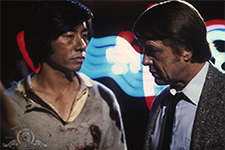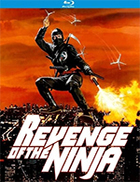Revenge of the Ninja
|  Released in the middle of the short-lived “ninja craze” in the U.S. in the early 1980s, Revenge of the Ninja confirmed the popularity of black-clad “shadow warriors,” whose existence was largely unknown outside of Asia before Ian Fleming introduced them to Western culture in his 1964 James Bond novel You Only Live Twice and its subsequent 1967 film adaptation. Kung-fu in the style of Bruce Lee dominated movie screens in the 1970s, but then ninjas took over, first with Enter the Ninja (1981), which was produced by The Cannon Group, a low-budget production/distribution company run by Israeli cousins Menahem Golan and Yoram Globus. Enter the Ninja hedged its bets by casting Italian star Franco Nero as the ninja protagonist and relegating Shô Kosugi, the actual martial artist, to the supporting villain role. Such was not the case with Revenge of the Ninja, where Kosugi gets to play the protagonist, while the villain is played by a white American who has also learned and trained in the ancient art of ninjitsu. Kosugi stars as Cho Osaki, a Japanese man whose entire family is slaughtered by ninjas outside of Tokyo in the film’s grisly opening sequence. At the behest of his American business partner, Braden (Arthur Roberts), he emigrates to the U.S. along with his elderly mother (Grace Oshita), and his infant son. We then cut ahead a half dozen years, where his son, Kane (Kane Kosugi) is a burgeoning martial arts maestro at the tender age of 7 and Cho is running a business selling imported Japanese statues in his art gallery. What he doesn’t realize is that his business is being used as a front to smuggle drugs by none other than Braden, his seemingly supportive business partner, who is secretly assassinating enemies in his ninja garb. Most of those enemies are the stooges of Caifano (Mario Gallo), an Italian-American mob boss with whom he has been doing business. Cho eventually realizes that he is caught in a turf war between Braden and Caifano, but not before Kane is kidnapped along with Cathy (Ashley Ferrare), a buxom blonde with whom Cho runs a dojo and has a tenuous romantic relationship. This means that Cho, who has sworn off the ways of the ninja when his family was killed by them, must once again don the black garb and start slinging swords, throwing stars, and otherwise taking out all the bad guys by getting truly medieval. The action culminates (not surprisingly) with a mano-a-mano showdown between Cho and Braden on the top of a skyscraper (the film was shot in Salt Lake City for budgetary reasons, although the location is never explicitly mentioned). Director Sam Firstenberg had only one feature film to his credit, the 1981 drama One More Chance, which meant that he had virtually no experience directing action. Ironically, the action scenes in Revenge of the Ninja are generally well executed and effective in their own right, although such cannot be said about the screenplay by James R. Silke (who would go on to write the screenplay for the 1984 Brooke Shields bomb Sahara and the ridiculous 1987 remake of King Solomon’s Mines), which is alternately monotonous and absurd. Firstenberg clearly relied heavily on the martial arts choreography, much of which Kosugi did himself, and not overthink anything, which is probably why he ended up directing mostly low-budget action, science fiction, and horror films for the rest of his career, including three ninja films: Ninja III: The Domination (1984), American Ninja (1985), and American Ninja 2: The Confrontation (1987). He was clearly given orders to spice things up, which is why the film is riddled with sometimes laughable bits of exploitation, including a naked hot tub scene that is shot like a slasher film and a sequence in which Cathy spars with Cho in a shorty robe and not much else. Firstenberg and cinematographer David Gurfinkel (Enter the Ninja, Over the Top) overuse slow motion from time to time, as well, including the throwing star assassination of a homeless man in a public fountain. Otherwise, though, the action flows well enough, and the only time the film grinds to a halt is when drama or character conflict is involved. Kosugi is a great martial artist, but not a particularly good actor. He doesn’t have Bruce Lee’s all-around intensity or Jackie Chan’s charm, so you find yourself waiting anxiously for his fists to start flying. His real-life son Kane is a marvel in his martial-arts prowess, and it is not surprising that he went on to his own extensive movie career. Keith Vitali makes for a rather humdrum villain, although Mario Gallo gives it his all as Caifano, playing the mobster as if he is doing the best (or worst) Joe Pesci impersonation of all time. Of course, the criminal intrigue element is rote stuff meant to connect the action scenes, and when the ninjas start going at it, it is easy to forget how bad the rest of it is.
Copyright © 2024 James Kendrick Thoughts? E-mail James Kendrick All images copyright © Kino Lorber | |||||||||||||||||||||||||||||
Overall Rating: 

 (2.5)
(2.5)


